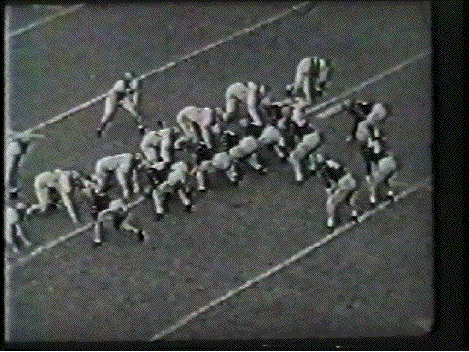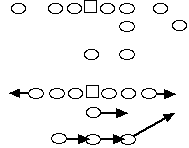LOOK AT "THE" SINGLE WING

The Undefeated 1950 Princeton Tigers
LOOK AT "THE" SINGLE WING

The Undefeated 1950 Princeton Tigers
There is no one "Single Wing," although you might think so, to hear people say somebody is running "the Single Wing." The appropriate response at that point should be, "what version?" The term "Single Wing" is an all-encompassing name given to any one of a wide variety of formations, whose only common feature often is nothing more than a direct snap to a man who is not "under center." Several - but by no means all - of these formations are shown below. At one time, a direct snap to one formation or another was the most popular offensive system. The Single Wing was last run in the NFL by the Pittsburgh Steelers in 1947 (the year Curly Lambeau of the Packers switched over to the T-formation), under famed Coach Jock Sutherland, who compiled a 30-17-1 NFL record with it; and although it lasted into the early 1960s at the college level, it is now all but extinct there. Versions of the Single Wing are, however, still being run successfully by a small but devoted band of high school coaches all over the country, and what is nowadays popularly called the "Shotgun" (a term first given to a formation "introduced" in 1960 by Red Hickey of the 49ers) is related to one or more of the formations below. Bear in mind that the diagrams below are just a representative sample, and bear in mind also that each of the formations shown is capable of several mutations. Coaches with questions, corrections or additions are welcome to contact me. (For anyone wanting to explore the subject in serious depth, the foremost authority on the history of Single Wing football is Ed Racely, of Atherton, California.)
 |
The Unbalanced Single-Wing of Fritz Crisler at Michigan, Bernie Bierman at Minnesota, Charley Caldwell at Princeton and George Munger at Penn. Its best-known present-day practitioner is Dr. Ken Keuffel, at New Jersey's Lawrenceville School |
 |
The "Wingback Deep" formation of Biggie Munn's Michigan State Multiple Offense, which featured shifting back & forth from T-formation to Single Wing, and even included a direct snap to the tailback between a T-formation QB's legs |
 |
Originally called the "Y formation", it has been made popular by John Aldrich, and his book "Single Wing Offense with the Spinning Fullback."It features more deception, less power, than a conventional single wing attack. |
 |
Glenn "Pop" Warner's Double-Wing, which he popularized at Stanford in the 1920's. It was designed to be a better passing formation, and to provide a better short side running game. The deep back could spin and hand off to either wingback. |
 |
The TCU "Double Tailback." Looks a lot like an unbalanced version of our Wildcat (see below) except that the twin tailbacks are 3-1/2 yards deep. |
 |
The "A" Formation employed in the NFL into the early 1950's by Steve Owen of the New York Giants. The line is unbalanced to one side, the backfield to the other. Owen claimed that it combined the speed and deception of the "T" formation with the power of the single wing. |
A SAMPLING OF BALANCED-LINE DIRECT-SNAP FORMATIONS
 |
At top is the Notre Dame Box of Knute Rockne; At bottom is the Notre Dame "T" formation, from which the Irish would shift rapidly into the Box with Wing Right or the Box with Wing Left, then quickly snap the ball before the defense had adjusted. (The rules were changed, eventually, to require a full-second stop after a shift.) Note the "nasty splits" by the ends. |
 |
This is the single wing run at Tennessee by General Robert Neyland, at UCLA by Red Sanders, at USC by Jess Hill, at Iowa State by Clay Stapleton, among others |
|
|
This is a balanced-line Double-Wing being run by Coach Roger Brookes at King William HS in Virginia. |
|
|
This is the direct-snap version of my Double-Wing, nicknamed the "Wildcat" set in honor of the mascot at the school where I first ran it. |
 |
TCU's Triple-Wing formation, the intermediate step between a balanced Double-Wing and the TCU Spread formation (below). |
 |
Short punt formation. It provided for deception in the ball handling, and proved to be a good passing formation. |
|
|
This is the Spread Formation developed by Dutch Meyer of TCU in the early 1950's, primarily for passing purposes. (Coach Meyer - and Coach Matty Bell before him - were largely responsible for the "wide-open" reputation of Southwest football.) The Spread began as a Tight Double-Wing and evolved into a Tight Triple-Wing, before splitting both ends. |